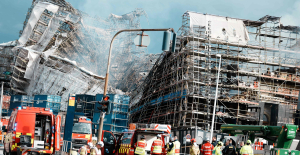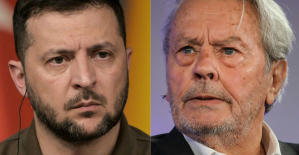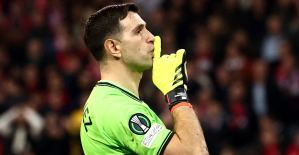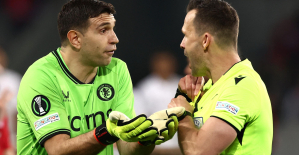Outside, the Havel sparkles in the sun, in the saloon of the "Katharina von Bora" coffee cups are steaming in front of chatting passengers. A spirit of optimism is palpable. Not only the guests, but also the ship is sailing the route for the first time.
But a dampener comes from the bridge: he congratulates the passengers on their courage, says Captain Manfred Kohn. You wouldn't have chosen the most attractive route.
There's simply nothing more boring than driving along canals, he said grumpily two days later. From a nautical point of view that may be true, after all it's straight ahead most of the time. Elbe-Havel Canal. Then the Mittelland Canal.
The passengers experience the eight-day canal trip differently. When they're not busy eating, they're on deck watching the landscapes go by at blood-pressure-dropping speeds. And on the excursions in the supposed province, they discover some real jewels instead of sadness.
Although the 23 crew members and 64 guests - room for 80 - are all fully vaccinated, many are happy not to have to cross state lines during the pandemic. There is something soothing about traveling within Germany.
The ship, built in 2000 and furnished in a traditional maritime style with lots of wood and brass, sails from Potsdam via Brandenburg an der Havel, Magdeburg, Wolfsburg, Hanover and Hameln to Münster in Westphalia. With a maximum of eighteen, mostly eleven kilometers per hour and numerous shore excursions, the appeal of the journey lies in its slowness.
But the passengers experience Potsdam all the faster, the city simply has too much to offer: the Glienicke Bridge, on the middle of which spies were exchanged during the Cold War and two worlds met.
Cecilienhof Palace, the residence of the last Crown Prince Wilhelm, where in August 1945 British Prime Minister Winston Churchill (soon replaced by Clement Attlee by ungrateful voters), US President Harry Truman and Josef Stalin met and discussed the fate of defeated Nazi Germany .
And then a quick walk around the Prussian King Frederick the Great Summer Palace Sanssouci and through the Dutch Quarter. Then the passengers are brought back to the ship with buzzing heads. You can see the rest on a tour of the Potsdam lakes before the captain takes on the waterway towards Brandenburg an der Havel.
Picturesque, the lavishly restored old town lies as a pleasant surprise in the Sunday afternoon sunlight. The guests swarm out, make it into the cathedral, which was built from 1165, just before it closes, and then stroll through the old town.
With 400 monuments on an area of 94 hectares, Brandenburg boasts the highest density of monuments in the federal state of the same name. Tonight they lie still and beautiful as a slumbering village, animated only by a few flocks of starlings.
Although Magdeburg is clearly located on the Elbe, the water level is often too low to enter the city. The "Katharina von Bora" moors behind the Magdeburg waterway crossing, which crosses the unreliable Elbe by means of a canal bridge. The passengers travel on by bus to the capital of Saxony-Anhalt.
Beautiful old and scattered prefabricated buildings alternate with numerous churches, which today mainly have a decorative function: a good eight percent of the residents are Protestant, almost four are Catholic, and the rest are unaffiliated. "The city is much more exciting than its reputation," says one cruise guest happily.
The excursionists visit the Gothic cathedral, consecrated in 1363, with the tomb of Emperor Otto, admire the richly landscaped Hundertwasser House with 55 different apartments and the monument to Martin Luther. The reformer preached in Magdeburg in 1524. In the old town, the gate of the old town hall presents the town's history in pictures.
The next day, some of the passengers walk along the canal to the Magdeburg waterway junction – an imposing structure. The canal bridge leads over the Elbe, is itself part of the Mittelland Canal and the largest structure of its kind in Europe. Large barges also push their way across the Elbe at a height of a good eight meters.
The cross, built between 1998 and 2003, did not live up to hopes of a dramatic increase in freight transport between East and West. But it also enables the “Katharina von Bora” to continue its journey towards Wolfsburg and Hanover. In the past, a kilometer-long detour was necessary.
Later on deck, retired engineers chat among the guests about canal construction, locks and ship lifts, others tell each other about their lives, read or watch what is happening on the bank: a heron flies up, ducks croak, a freighter comes from the front. Wave to passers-by on the shore.
The sight of the 83 meter long and nine and a half meter wide river boat with the eye-catching blue and red bow on the canal is obviously also worth a look for the local residents. From time to time a member of the crew reminds the passengers to take a seat. Because some of the bridges – there are 330 on the Mittelland Canal alone – are so low that the captain even has to lower the wheelhouse so that his ship can pass them unscathed.
Meanwhile, the "Katharina von Bora" is gliding west through lush green provinces. In the late afternoon she arrives in Wolfsburg, where a canalside lounge bar with music, sand heaps and cocktails fights against the city's cool industrial image. At first glance, Wolfsburg seems to offer nothing more than the Volkswagen Autostadt on one bank of the canal and the train station and art museum on the other.
But as is so often the case, it is worth taking a second look in Wolfsburg: the city has a castle with a 700-year history. Around 1600, the well-fortified moated castle was expanded into a presentable Renaissance-style aristocratic residence and is now home to the municipal gallery, which is well worth seeing and has a focus on German art since 1945. The village, which once flourished in the shadow of the castle, has also preserved a few half-timbered buildings including the village tavern .
Back on board, passengers work their way through the three-course lunch. Later you doze on deck, listening to cruise director Maggy Glaser's explanations about the Mittelland Canal - at 392 kilometers including connecting canals, Germany's longest artificial waterway.
You strengthen yourself again, now with cake, maybe read a book and start thinking about an aperitif. After dinner, pianist Ivan plays. Individual couples venture onto the floor. Later, the film "Katharina Luther" illuminates the story of Martin Luther's wife, who lends her maiden name to the ship.
A reunion with the reformer awaits the passengers in Hanover, where he stands on a pedestal in front of the market church. Guide Florian Meier does everything to clean up the "Nothing is stupider than Hanover" image.
He bravely entertains the guests with anecdotes about the Guelph descendants Ernst August von Hanover or Gerhard Schröder, with details about Guelph castles, baroque gardens, the Maschsee and classicist buildings from the 19th century. In the end, everyone is convinced that the state capital of Lower Saxony is anything but boring.
In Hamelin, which is half an hour's bus ride from the ship's anchorage in Minden, the rain is pouring down and obscuring the Weser Renaissance facades and half-timbered houses of the old town behind a veil of haze. The guide appears in the costume of the Pied Piper, the pictures of rats on the floor show the way to the most beautiful buildings and the cathedral of the city with its Romanesque crypt.
What is true about the story of the Pied Piper, who was cheated of his wages by the citizens and who, after the rats, is said to have lured (almost) all the children out of the city and into ruin in 1284, is not clear. But Hamelin has managed to turn the unfortunate episode into a lucrative business.
“At first I was skeptical about the route,” Captain Kohn later admitted at the farewell reception. He only heard positive things from the guests. Even talked shop with some about towing and economy locks and waterway crossings, and finally realized that his initial assessment was possibly based on professional blindness.
The guests smile indulgently and raise their glasses. Later that evening, Kohn steers the "Katharina von Bora" into the inland port of Münster. More than sixty churches, a few hundred pubs, half a million bicycles and 60,000 students characterize the beautiful city.
Here guests stay one last night on board. The next day the harbor is covered in drizzle, parting words fly through the air, pianist Ivan waves goodbye.
The eight-day trip from Potsdam to Münster (or vice versa) can be booked with full board at Nicko Cruises from 1249 euros per person. The next travel dates are planned for October 2023. The shipping company also offers river cruises on other German rivers such as the Rhine, Danube and Oder.
River cruises can also be booked with other providers. In 2022, A-Rosa is offering a four-day cruise "Rhine short cruise Main
Participation in the voyage was supported by Nicko Cruises. You can find our standards of transparency and journalistic independence at axelspringer.com/de/Werte/downloads.
This article was first published in December 2021.

 Sydney: Assyrian bishop stabbed, conservative TikToker outspoken on Islam
Sydney: Assyrian bishop stabbed, conservative TikToker outspoken on Islam Torrential rains in Dubai: “The event is so intense that we cannot find analogues in our databases”
Torrential rains in Dubai: “The event is so intense that we cannot find analogues in our databases” Rishi Sunak wants a tobacco-free UK
Rishi Sunak wants a tobacco-free UK In Africa, the number of millionaires will boom over the next ten years
In Africa, the number of millionaires will boom over the next ten years WHO concerned about spread of H5N1 avian flu to new species, including humans
WHO concerned about spread of H5N1 avian flu to new species, including humans New generation mosquito nets prove much more effective against malaria
New generation mosquito nets prove much more effective against malaria Covid-19: everything you need to know about the new vaccination campaign which is starting
Covid-19: everything you need to know about the new vaccination campaign which is starting The best laptops of the moment boast artificial intelligence
The best laptops of the moment boast artificial intelligence Bitcoin halving: what will the planned reduction in emissions from the queen of cryptos change?
Bitcoin halving: what will the planned reduction in emissions from the queen of cryptos change? The Flink home shopping delivery platform will be liquidated in France
The Flink home shopping delivery platform will be liquidated in France Bercy threatens to veto the sale of Biogaran (Servier) to an Indian industrialist
Bercy threatens to veto the sale of Biogaran (Servier) to an Indian industrialist Switch or signaling breakdown, operating incident or catenaries... Do you speak the language of RATP and SNCF?
Switch or signaling breakdown, operating incident or catenaries... Do you speak the language of RATP and SNCF? The main facade of the old Copenhagen Stock Exchange collapsed, two days after the fire started
The main facade of the old Copenhagen Stock Exchange collapsed, two days after the fire started Alain Delon decorated by Ukraine for his support in the conflict against Russia
Alain Delon decorated by Ukraine for his support in the conflict against Russia Who’s Who launches the first edition of its literary prize
Who’s Who launches the first edition of its literary prize Sylvain Amic appointed to the Musée d’Orsay to replace Christophe Leribault
Sylvain Amic appointed to the Musée d’Orsay to replace Christophe Leribault Skoda Kodiaq 2024: a 'beast' plug-in hybrid SUV
Skoda Kodiaq 2024: a 'beast' plug-in hybrid SUV Tesla launches a new Model Y with 600 km of autonomy at a "more accessible price"
Tesla launches a new Model Y with 600 km of autonomy at a "more accessible price" The 10 best-selling cars in March 2024 in Spain: sales fall due to Easter
The 10 best-selling cars in March 2024 in Spain: sales fall due to Easter A private jet company buys more than 100 flying cars
A private jet company buys more than 100 flying cars This is how housing prices have changed in Spain in the last decade
This is how housing prices have changed in Spain in the last decade The home mortgage firm drops 10% in January and interest soars to 3.46%
The home mortgage firm drops 10% in January and interest soars to 3.46% The jewel of the Rocío de Nagüeles urbanization: a dream villa in Marbella
The jewel of the Rocío de Nagüeles urbanization: a dream villa in Marbella Rental prices grow by 7.3% in February: where does it go up and where does it go down?
Rental prices grow by 7.3% in February: where does it go up and where does it go down? With the promise of a “real burst of authority”, Gabriel Attal provokes the ire of the opposition
With the promise of a “real burst of authority”, Gabriel Attal provokes the ire of the opposition Europeans: the schedule of debates to follow between now and June 9
Europeans: the schedule of debates to follow between now and June 9 Europeans: “In France, there is a left and there is a right,” assures Bellamy
Europeans: “In France, there is a left and there is a right,” assures Bellamy During the night of the economy, the right points out the budgetary flaws of the macronie
During the night of the economy, the right points out the budgetary flaws of the macronie These French cities that will boycott the World Cup in Qatar
These French cities that will boycott the World Cup in Qatar Europa Conference League: the semi-final flies to Lille, which loses to the wire against Aston Villa
Europa Conference League: the semi-final flies to Lille, which loses to the wire against Aston Villa Lille-Aston Villa: Cash disgusts Lille, the arbitration too... The tops and the flops
Lille-Aston Villa: Cash disgusts Lille, the arbitration too... The tops and the flops Handball: Les Bleues in the same group as Spain at Euro 2024
Handball: Les Bleues in the same group as Spain at Euro 2024 Europa Conference League: for Létang, Martinez “does not have the attitude of a high-level athlete”
Europa Conference League: for Létang, Martinez “does not have the attitude of a high-level athlete”


















